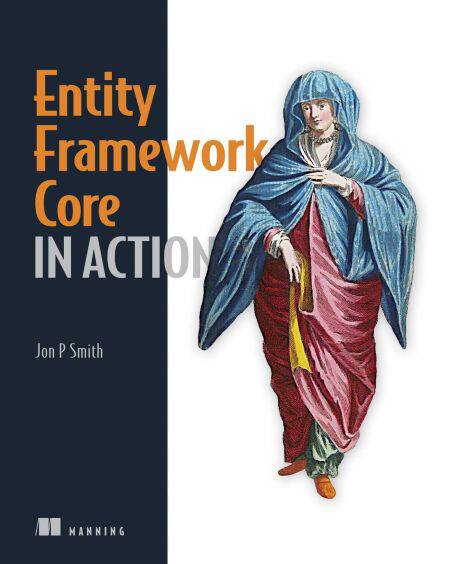
- Afhalen na 1 uur in een winkel met voorraad
- Gratis thuislevering in België vanaf € 30
- Ruim aanbod met 7 miljoen producten
- Afhalen na 1 uur in een winkel met voorraad
- Gratis thuislevering in België vanaf € 30
- Ruim aanbod met 7 miljoen producten
Zoeken
Omschrijving
Summary
Entity Framework Core in Action teaches you how to access and update relational data from .NET applications. Following the crystal-clear explanations, real-world examples, and around 100 diagrams, you'll discover time-saving patterns and best practices for security, performance tuning, and unit testing.
Purchase of the print book includes a free eBook in PDF, Kindle, and ePub formats from Manning Publications.
About the Technology
There's a mismatch in the way OO programs and relational databases represent data. Entity Framework is an object-relational mapper (ORM) that bridges this gap, making it radically easier to query and write to databases from a .NET application. EF creates a data model that matches the structure of your OO code so you can query and write to your database using standard LINQ commands. It will even automatically generate the model from your database schema.
About the Book
Using crystal-clear explanations, real-world examples, and around 100 diagrams, Entity Framework Core in Action teaches you how to access and update relational data from .NET applications. You'l start with a clear breakdown of Entity Framework, long with the mental model behind ORM. Then you'll discover time-saving patterns and best practices for security, performance tuning, and even unit testing. As you go, you'll address common data access challenges and learn how to handle them with Entity Framework.
What's Inside
Querying a relational database with LINQ Using EF Core in business logic Integrating EF with existing C# applications Applying domain-driven design to EF Core Getting the best performance out of EF Core Covers EF Core 2.0 and 2.1
About the Reader
For .NET developers with some awareness of how relational databases work.
About the Author
Jon P Smith is a full-stack developer with special focus on .NET Core and Azure.
Table of Contents
Part 1 - Getting started Introduction to Entity FrameworkCore Querying the database Changing the database content Using EF Core in business logic Using EF Core in ASP.NET Core web applications Part 2 - Entity Framework in depth Configuring nonrelational properties Configuring relationships Configuring advanced features and handling concurrency conflicts Going deeper into the DbContext Part 3 - Using Entity Framework Core in real-world applications Useful software patterns for EF Core applications Handling database migrations EF Core performance tuning A worked example of performance tuning Different database types and EF Core services Unit testing EF Core applications Appendix A - A brief introduction to LINQ Appendix B - Early information on EF Core version 2.1
Entity Framework Core in Action teaches you how to access and update relational data from .NET applications. Following the crystal-clear explanations, real-world examples, and around 100 diagrams, you'll discover time-saving patterns and best practices for security, performance tuning, and unit testing.
Purchase of the print book includes a free eBook in PDF, Kindle, and ePub formats from Manning Publications.
About the Technology
There's a mismatch in the way OO programs and relational databases represent data. Entity Framework is an object-relational mapper (ORM) that bridges this gap, making it radically easier to query and write to databases from a .NET application. EF creates a data model that matches the structure of your OO code so you can query and write to your database using standard LINQ commands. It will even automatically generate the model from your database schema.
About the Book
Using crystal-clear explanations, real-world examples, and around 100 diagrams, Entity Framework Core in Action teaches you how to access and update relational data from .NET applications. You'l start with a clear breakdown of Entity Framework, long with the mental model behind ORM. Then you'll discover time-saving patterns and best practices for security, performance tuning, and even unit testing. As you go, you'll address common data access challenges and learn how to handle them with Entity Framework.
What's Inside
Querying a relational database with LINQ Using EF Core in business logic Integrating EF with existing C# applications Applying domain-driven design to EF Core Getting the best performance out of EF Core Covers EF Core 2.0 and 2.1
About the Reader
For .NET developers with some awareness of how relational databases work.
About the Author
Jon P Smith is a full-stack developer with special focus on .NET Core and Azure.
Table of Contents
Part 1 - Getting started Introduction to Entity FrameworkCore Querying the database Changing the database content Using EF Core in business logic Using EF Core in ASP.NET Core web applications Part 2 - Entity Framework in depth Configuring nonrelational properties Configuring relationships Configuring advanced features and handling concurrency conflicts Going deeper into the DbContext Part 3 - Using Entity Framework Core in real-world applications Useful software patterns for EF Core applications Handling database migrations EF Core performance tuning A worked example of performance tuning Different database types and EF Core services Unit testing EF Core applications Appendix A - A brief introduction to LINQ Appendix B - Early information on EF Core version 2.1
Alleen bij Standaard Boekhandel
+ 43 punten op je klantenkaart van Standaard Boekhandel
Beoordelingen
We publiceren alleen reviews die voldoen aan de voorwaarden voor reviews. Bekijk onze voorwaarden voor reviews.









